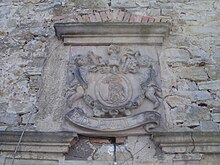Alach monastery
The monastery Alach was a 1104 First mentioned monastery in Alach in Erfurt that the until 1803 Peter Monastery Erfurt belonged. The preserved mansion is designated as a cultural monument , stands empty and is acutely threatened with decay.
history
According to a deed of ownership from 1104, the estate belonged to the Benedictine monastery of St. Peter and Paul in Erfurt and had an area of approx. 400 hectares. In the second half of the 14th century, the monastery pledged a large part of its land in Alach to the city of Erfurt, partly to the patrician family von der Sachsen, which in turn sold half of them to the city of Erfurt 200 years later. Nevertheless, the monastery still had a large piece of land that was supplied from the monastery courtyard.
In 1482 an older manor house was mentioned, which was replaced by the existing building at that time. It is a rectangular, two-storey quarry stone building with a hipped roof . In the eastern part there is a chapel built over both floors , which was illuminated through high Gothic, ogival tracery windows. In addition to church services, baptisms and weddings, pilgrimages also took place there. Every year the so-called abbot dinner took place, which was served here by the new officials and community leaders of the community for the abbot and his entourage. Until March 23, 1803, the Peterskloster had the right to visit St. Ulrich's Church, so that the respective abbot of the Peterskloster appointed the pastors of the village of Alach.
After the buildings had suffered considerable damage during a siege by Elector Johann Philipp von Schönborn in 1664 , they were then repaired and expanded to include a granary and in 1698 by Nicolaus de Gouverneur (Abbot 1682–1705) another manor building. In 1713 the existing mansion was converted by Placidus Casselmann (abbot 1705–1737) as a residence for the tenant families. The St. Marienkapelle was equipped with an organ by the Erfurt organ builder Johann Georg Schröter in 1715 .
On March 23, 1803, the monastery and the Peterskloster were secularized . The Prussian government sold the estate to a private person in 1822. A coat of arms from 1698 from the barn that burned down in 1864 was placed over the entrance door of the chapel in 1923. The chapel was used for storage purposes from 1803 to 1948. It was not until after the Second World War, when hundreds of Catholic expellees from the eastern German territories also settled in Alach, that considerations arose to use the old chapel again according to its original purpose.
At Easter 1950 the church was consecrated again as a Catholic church for Alach by the vicar general of the diocese of Fulda , based in Erfurt, Joseph Freusberg . In the following years the church invested a lot of money and work in order not to let the monastery property fall into disrepair.
In 1994 the community was given notice and the house was sold to private individuals. The last service took place on Christmas Eve of the year, since then it has expired.
literature
- Alach , In: Georg Dehio Handbuch Thuringia, Munich-Berlin 1998
Web links
Individual evidence
- ↑ Anne Martin: The monastery in Alach is a real ruin . In: Thüringer Allgemeine from February 18, 2012. Retrieved May 8, 2013
Coordinates: 50 ° 59 ′ 13.8 " N , 10 ° 55 ′ 45.3" E



